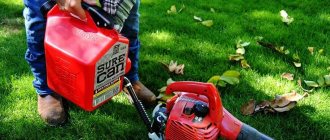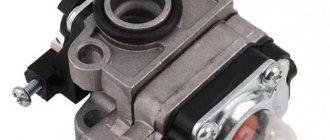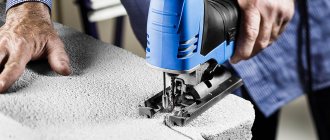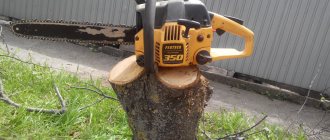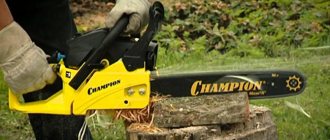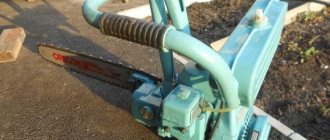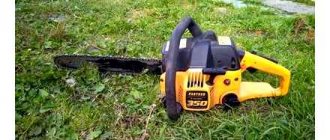The chainsaw stalls at idle speed: many owners of this tool face this problem. In terms of its design, the saw is a fairly simple tool. But there are times when it fails. The main problem in troubleshooting is determining the correct cause of abnormal operation . Once the cause is identified, eliminating the defect is usually quite simple.
Circuit diagram of a chainsaw.
Probable reasons for failure
The power unit of all chainsaws is a single-cylinder internal combustion engine. Devices of this type are characterized by such malfunctions as violations of intra-cylinder compression, changes in the fuel mixture ratio, incorrect ignition operation, and low-quality fuels and lubricants. The main problems in the operation of the power unit are the following:
- the engine runs stably at minimum speeds, but stalls when the speed increases;
- the start-up occurs normally, but the idle speed is unstable and stalls quickly;
- won't start.
Electronic ignition circuit for a chainsaw.
Abnormal idle operation can be caused by various reasons. They can be divided into several positions:
- reduced filter capacity (gasoline and air);
- abnormal operation of the ignition system:
- the carburetor settings changed spontaneously;
- malfunction of fuel line elements;
- exhaust channels and muffler are clogged;
- defects of the piston, cylinder, valves.
Repairs should begin with an external inspection and checking the presence of fuel in the tank.
Problems associated with improper operation of the fuel system
The chainsaw periodically stalls at idle also due to a violation of the integrity of the fuel line or an incorrect ratio of the ingredients of the “fuel mixture” consisting of gasoline and oil.
Before each switching on of the cutting mechanism, it is necessary to visually inspect its blocks and components, paying attention to possible defects in the surface of the housing, mechanical damage, and leaks of working fluids. This should also be done for the saw's fuel line, which is usually a rubber tube.
If the device was (especially for a long time) in a damp place and had to withstand sharp fluctuations in air temperatures, this tube could simply crack. This fuel line is not suitable for further use and should be replaced.
Another reason why a chainsaw may stall at idle is failure to comply with the ratio of ingredients when preparing the “fuel mixture”. The proportions of gasoline and oil included in it must exactly correspond to the branded instructions for a particular device. If they are not followed, the engine will not be sufficiently lubricated, and the entire mechanism will persistently stall.
Checking and repairing filters
The engine may run rough or stall if there is not enough fuel or air. Causes: clogged air or fuel filter. To check the fuel filter, you need to remove the fuel line hose from the carburetor fitting and direct it into a container. Then press the fuel pump several times. If the fuel is pumped normally, in clearly defined doses, without dirt, then the fuel filter is working properly. If the stream is weak or fuel is not pumped at all, the filter needs to be replaced or, if possible, cleaned.
Clogging of the fuel filter with sawdust is one of the reasons for chainsaw failure.
The device must be removed from the fuel tank (after draining all the fuel from it). On most models, the fuel filter can be pulled out with a wire hook through the neck. If the filter design is dismountable and can be cleaned, it must be disassembled and washed in accordance with the manufacturer’s recommendations. Otherwise, replace it with a new filter.
Similar problems can arise when the air filter is clogged with dust, sawdust, or dirt. If there is insufficient air, the fuel mixture will be enriched and the fuel combustion process will be difficult.
To check, remove the filter. During operation, precautions must be taken to prevent dust from entering the carburetor. The device must be cleaned and rinsed in warm water with added detergent. After drying, if possible, blow with low-pressure compressed air and reinstall. If the chainsaw works normally, then the cause has been eliminated; if not, you need to look further.
If the tool is used continuously, it is recommended to replace the filters of the fuel and air systems after 3 months.
Why does it stall at full speed?
Very often you can hear the question why a chainsaw stalls at full speed. There may be several reasons. First, you need to consider exactly how the saw stalled.
Let's say the tool was working normally and suddenly, for no apparent reason, it suddenly stalled and the starter does not turn over. In such a situation, you can be 100% sure that the chainsaw is jammed and you need to start overhauling it.
The second situation is when the Shtil 180 chainsaw worked normally, then gradually lost power in a short time and stalled, and the cylinder overheated.
In this case, the most likely reason is air leakage under the rubber pipe connecting the carburetor to the cylinder or its rupture. The mixture became lean, resulting in overheating. The cause can be eliminated by changing the pipe.
Checking the spark plug and ignition system
According to manufacturers' recommendations, the spark plug should be changed annually, regardless of the intensity of use of the tool. Failure to follow these tips leads to a completely natural result: failures at idle speed and subsequent failure.
Typical ignition system defects are as follows:
Faulty chainsaw spark plugs.
- The spark plug was filled with fuel at the time of start-up. It is necessary to remove it from the socket, dry it, and, if possible, blow it with compressed air. Drain the remaining fuel from the cylinder through the installation hole and blow it out with compressed air. Then install the spark plug, connect the high-voltage wire, and start it.
- No spark at the spark plug electrodes. You need to disconnect the high-voltage wire and check for a spark on it. If the spark is normal, check the connection and eliminate any defects found. The absence of a spark on the high-voltage wire indicates a malfunction of the ignition unit. This device cannot be repaired; it must be replaced with a new one.
- The gap between the spark plug electrodes is broken. This parameter for different types of devices can range from 0.2 to 0.5 mm. Checking and adjustments must be performed using a special probe or caliper. The required value can be found in the operating instructions for the tool.
- By the appearance of the candle, you can determine the direction of the search. If the spark plug turns out to be dry after several attempts to start the engine, it means that gasoline is not entering the cylinder. It is necessary to check the fuel supply system and carburetor.
- The presence of black soot or carbon deposits on the electrodes indicates incorrect carburetor adjustment or a clogged air filter. Possibly low-quality fuel with a high oil content is used. During normal operation of the ignition system, the electrodes have a uniform gray color and a brown coating on the insulators.
Malfunctions of the cylinder-piston group
It is possible that even after eliminating all the listed causes of malfunctions, the chainsaw will continue to stall at idle or not start at all. In this case, you will have to look into the very heart of the engine - its cylinder.
Sometimes even a visual inspection is enough to determine what is wrong with the cylinder-piston group. Chips, scuffs, obvious wear of the cylinder and other visible defects are direct obstacles to the normal operation of the device. Without any doubt, such spare parts must be replaced.
If there is no obvious damage, then you need to examine the piston rings. It is damage to these rings that leads to loss of engine power. Too free movement of the rings in the cylinder grooves indicates that it is time to replace these spare parts with new ones.
Meanwhile, a complete picture of the technical condition of this group of parts can only be obtained after a complete disassembly of the engine. Since this is a labor-intensive, responsible task that requires certain professional experience, it is better to entrust it to a specialist. This is the only way to extend the working life of man’s great assistant – the chainsaw.
Carburetor check and repair
The operating principle of a chainsaw carburetor.
If checking the ignition system, fuel filters, and muffler did not produce tangible results, the tool still does not want to work normally at minimum speed, you need to check the carburetor.
To adjust the operating modes, there are three screws on the device body designed to set the minimum rotation speed, maximum speed and idle speed.
On many models, manufacturers install only the idle air adjustment screw to avoid incompetent attempts to adjust the device. In all versions of the device, adjustment must be performed exactly according to the manufacturers' recommendations.
If adjusting the device does not restore normal operation of the instrument, you need to completely disassemble the device and inspect it. It should be understood that a carburetor is a rather complex device; if you lack experience, it is advisable to contact specialists.
When disassembling, it is important to carefully inspect and wash all jets, air and fuel channels, and filter mesh. Damaged elements must be replaced with new ones. The jets must be cleaned with soft wire of the appropriate diameter.
It is advisable to carry out work in appropriate conditions. The carburetor contains many small parts, the loss of any of them will render the device inoperable.
Structural components of a chainsaw
All chainsaws are similar in structure, regardless of whether they are made in Europe (ECHO, Stihl, Husqvarna) or domestic (Kedr, Ural).
Inside the body there are the main elements - the fuel tank and the engine, and outside there is a starter, a handle, a saw part (tire) with a chain. A sharp tug of the cable starts the engine, and it starts the saw blade. From time to time, malfunctions occur in the operation of the saw, which require disassembly to eliminate. What can happen to such a simple mechanism as a chainsaw? At least the following:
- Stops starting;
- It starts, but soon stops;
- Stops functioning when cutting;
- Loses its power;
Most problems are associated either with interruptions in engine operation (fuel supply system, exhaust system, ignition, cylinder-piston part), or with malfunctions of other systems and components (clutch, chain brake, tire, lubrication system). Let's look at the most common breakdowns and methods for eliminating them.
A serviceable chainsaw starts with one pull and does not fail to cut
Muffler inspection and repair
Clogged mufflers should be left to soak in warm water and detergent, then wiped thoroughly and dried.
A malfunction of the muffler leads to a drop in the power of the tool during operation and stops in idle mode. Despite the apparent simplicity of this detail, it is also important to keep an eye on it. Quite often the muffler becomes clogged. During operation, it is possible that wood dust, sawdust, and resin particles may get on the grate. High temperatures cause them to stick and accumulate; exhaust gases also form deposits on the surfaces of the spark arrestor and other parts. The layer that increases over time reduces the throughput of the muffler and interferes with the normal removal of exhaust gases. The engine, figuratively speaking, is choking.
Repairing this unit is not difficult and is within the capabilities of many tool owners. The device should be removed from the engine, the holes should be covered with a rag or other material. If the resulting layer is too hard, all parts can be left to soak in warm water and detergent. After the plaque has softened, the parts should be washed with a rag or soft brush and wiped thoroughly. Inaccessible areas can be blown with compressed air or dried with a hairdryer. The use of mechanical means of removal is not advisable.
For normal operation of the muffler over a long period of operation, you should use lubricants recommended by the manufacturer, monitoring their expiration dates. The mixture must be prepared immediately before work and consumed completely.
What to do if the chainsaw continues to not start?
If the initial inspection did not yield anything or the defects were eliminated during the search process, but the chainsaw still does not start, then you need to look for more serious reasons. It is best to identify and repair such breakdowns at a service center. However, if you have experience, you can find and eliminate them yourself. What to diagnose and check?
- Compression in the cylinder;
- Compression in the crankcase;
- Carburetor operation.
In the first case, checking the compression in the cylinder will allow you to find out the condition of the cylinder-piston group (CPG) of a chainsaw that does not want to start when cold. To do this you need a compression gauge. The device is screwed into place of the spark plug and the engine is started idle. Measuring the readings allows you to judge the condition of the CPG. In the absence of a compression gauge, you can determine the compression in the cylinder offhand as follows:
- Place your finger on the spark plug hole;
- Try to start the chainsaw engine.
By placing your finger on the spark plug hole and pulling the starter, you can check the compression in the cylinder
If you feel that your finger is being pulled strongly into the spark plug channel, then everything is in order with compression. The absence of vacuum in the chamber indicates a malfunction. The cylinder-piston group needs a more detailed inspection, which will give an idea of the condition of the piston and cylinder, piston rings and bearings.
A chainsaw may not start when cold due to a lack of compression in the engine crankcase. The main reason for this is damage to the gasket located between the cylinder and the crankcase. It is quite easy to detect a lack of compression:
- Disconnect the upper tube from the carburetor;
- Pour gasoline into a regular cork;
- We immerse the removed tube in the fuel;
- We pull the starter several times.
If fuel is sucked out of the cap when the chainsaw starter starts, then everything is fine with compression. If not, look at the gasket.
If the fuel is drawn in, then everything is fine - the gasket is intact. Otherwise, you will have to purchase a repair kit and make a replacement. How to do this, watch the video why a Chinese chainsaw won’t start:
Starting the tool may be complicated by improper operation of the carburetor or its breakdown. It often happens that during the sawing process the fastening screws become loose and air is sucked into the cylinder. Check that the carburetor is securely fastened. Inspect it for fuel leaks. There can be many reasons for the malfunction. It is possible to accurately determine the malfunction, eliminate it and fine-tune the carburetor only at a service center.
After going through a step-by-step troubleshooting of the chainsaw engine, you will be able to find the malfunction, fix it yourself and successfully start your working tool. Do not take on types of work that you are not confident in. Entrust troubleshooting and troubleshooting to specialists from the service center.
Read also from the section
Agriculture of New Holland
New Holland Agriculture New Holland is a global brand of agricultural machinery manufactured by CNH Industrial. New Holland's agricultural products include tractors, combines, balers, forage harvesters, self-propelled sprayers, hay tools, seeding equipment, hobby tractors, trucks and implements, and grape harvesters. The original New Holland Machine Company was founded in 1895 in New Holland,
Carburetor repair, maintenance - setup guide
Your Briggs and Stratton carburetor is an integral part of your small engine, so keeping it running smoothly is important to the overall health of your lawn mower, snow blower and other outdoor power equipment. In this article, we'll give you carburetor maintenance and repair tips that will help keep your little engine running smoothly so you can use it without problems.
Ryobi RY253SS Review
Pros / This gas trimmer has an 18-inch cutting radius. Cons / This trimmer weighs just over twelve pounds. Verdict / Ryobi RY253SS. it is an affordable, versatile tool that can support multiple attachments. The wide cutting path makes it a good choice for most yards, but for longer jobs you may feel the strain due to the somewhat uneven weight distribution.
Some maintenance tips
Careful adherence to the operating and maintenance instructions for the tool is a guarantee of its long and trouble-free operation. It is worth considering that each part of the chainsaw has its own resource, so they need to be changed in a timely manner.
The rules for working with the tool are as follows:
- Before each installation, check that the chain is in good working order and has sufficient tension.
- Use only a well-sharpened chain for work.
- After using the saw, clean all components from sawdust.
- Rotate the tire for even wear. At the same time, lubricate the sprocket.
- If storing for a long time, drain the fuel and oil.
With improper operation and maintenance, not only budget-class instruments, but also quite prestigious models from well-known manufacturers are susceptible to spontaneous failures. To maintain the functionality of your chainsaw, follow the recommendations of professionals.
